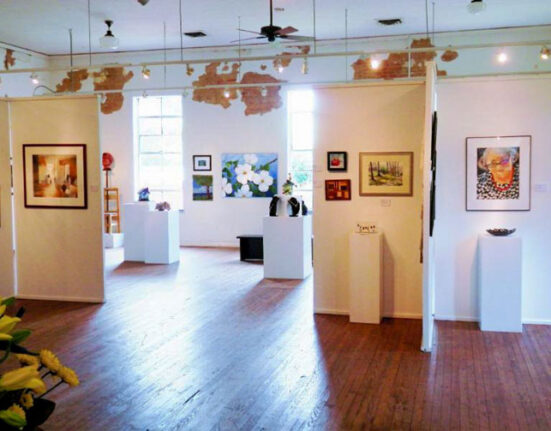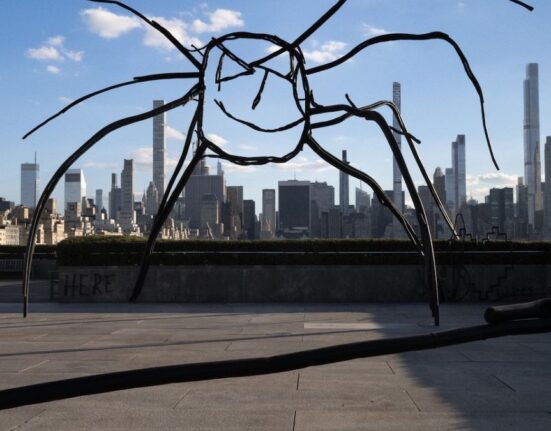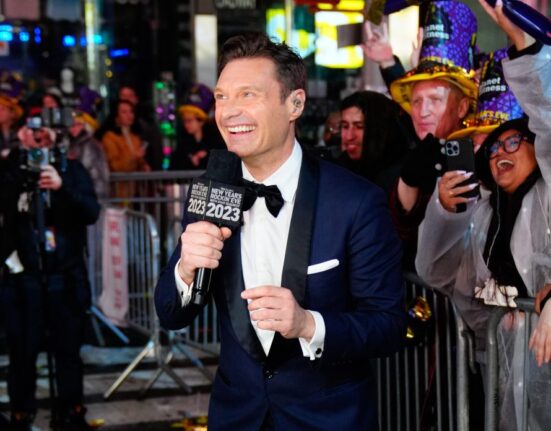Overview:
In an in-depth conversation with The Haitian Times, Manuel Mathieu delves into the experiences that shaped his artistic vision — from his childhood in Port-au-Prince to a near-fatal accident to living life to the fullest.
MIAMI — From a childhood in Port-au-Prince where he was surrounded by art, Manuel Mathieu has taken his own work to exhibition spaces in China, Canada and the United Kingdom. Over the years, the Haiti-born multidisciplinary artist has showcased a distinctive blend of storytelling and visual exploration that engages audiences across cultural boundaries.
Now, at 37, Mathieu is arriving at yet another significant milestone in his career: two solo exhibits at the Museum of Contemporary Art North Miami (MOCA Nomi). The dual showcase projects Mathieu’s celebrated ability to intertwine vibrant aesthetics with profound themes. It is also in the representation of Haitian art on a global stage.
“These exhibitions are a culmination of my lifelong journey,” Mathieu in an exclusive conversation with The Haitian Times. “They capture the essence of my explorations—both within Haiti’s history and within myself.”
The MOCA Nomi exhibitions — “World Discovered Under Other Skies” and “Dwelling on the Invisible” — feature a captivating array of paintings, drawings and ceramics. They are particularly groundbreaking because of Mathieu’s deep dive into Haiti’s complex and often turbulent history. In addition to displaying Mathieu’s artistic prowess, the collections’ profound narratives aim to guide viewers through the landscapes of Haiti’s past and present.
Each piece also reflects Mathieu’s unique perspective, informed by his personal experiences and the collective memory of his homeland.
The MOCA exhibitions are available until October 6. Meanwhile, Mathieu continues to seek and explore new avenues, both within and beyond visual art. His recent ventures into perfume making and documentary filmmaking are a testament to his boundless curiosity and innovative spirit.
“I wouldn’t change a day in my life.” Mathieu expressed. “I want it all.”
In an exclusive conversation with The Haitian Times, Mathieu offers a glimpse into the experiences that shaped his artistic vision. Discussing his childhood surrounded by art and a near-fatal accident, self-discovery and creating with urgency, to becoming an entrepreneur, Mathieu invites us into his world.
The interview has been lightly edited for clarity.
The beginning: Influences at a young age
Growing up in Port-au-Prince, Mathieu was surrounded by a rich artistic influence. He was born into a low to middle-class family just months after the fall of Jean-Claude Duvalier’s regime and was the eldest of three children. His mother’s extensive collection of Haitian art and the mentorship of his cousin, Mario Benjamin, played pivotal roles in shaping his early creative aspirations.
The Haïtian Times: How would you describe your upbringing growing up in Port-au-Prince? What was your childhood like?
Manuel Mathieu: I grew up in a gingerbread house, surrounded by paintings and sculptures. My cousin, Mario Benjamin, introduced me to western artists and artists from the country. These introductions to the world of art led me to create art installations in my room and to pick up photography in my late teens, eventually leading me to being accepted into an undergraduate program at Goldsmiths, University of London.
While my younger years were immersed in art, I hadn’t yet fully accepted the calling to become an artist. The decision to become one was predicated on the idea of living forever.
THT: You mentioned that you were called to be an artist. Was there ever a point in your life where you denied that calling?
MM: I think what called me first was the freedom and excitement of being an artist. At first, it didn’t make any sense to me to be an artist. What did I know about being an artist when I was 15 years old? The artists I discovered through the catalogs and books that Mario shared with me were leaving behind what they had in their souls, and I found that fascinating. I wanted to live like that forever. It wasn’t that I wanted to be an artist; it was more like I wanted to live like that forever.
THT: During the conversation at MOCA, you described your teen years as being a “difficult teenager with an “I don’t care” attitude. What did that look like for you?
MM: I was a “difficult teenager” with an “I don’t care” attitude who didn’t take much heed of my parents’ discipline. They couldn’t tell me what to do, but I was still good at school, so it wasn’t really an issue when it came to that. But, I can only imagine in a country like Haiti how hard that could be.
THT: You mentioned that your grandmother taught you pure love and acceptance, and I wanted to know, experiencing your grandmother’s love, how would you, now, define love?
MM: I think pure love is about accepting people. Accepting the person that you love. It’s hard to do that because we’re like uneven rocks. We’re full of flaws. And we’re hiding a lot of it, which is fair, because we don’t want to be exposed. Because when they see you, you cannot unsee people. I don’t think she saw me, but she accepted me before seeing me — which is the most beautiful kind of love.
THT: How has your rebellious spirit and your idea of love shaped your perspective and how does that translate into your art?
MM: The rebellious side of me taught me to always build the courage to do whatever I want to do. You know, it is hard to live the life of an artist. But if you have the courage to get to the bottom of it, it’s really beautiful. I think I brought that courage into my work because I can decide to embrace difficult subjects, subjects that are very hard to deal with, to engage with, or that some people would argue are impossible to talk about. I like to go there and not be afraid to get lost.
When I was recovering from the accident, I spent a lot of time alone. There are some roads that are lonely. The road that is yours can be lonely. But you have to learn to be with yourself and embrace your destiny to a certain point.
The crash: A turning point
In 2015, Mathieu’s life took a dramatic turn during his studies at Goldsmiths, University of London. A hit-and-run motorbike accident left him with a severe concussion and short-term memory loss. This traumatic event not only halted his physical capabilities but also forced a profound period of introspection.
To complete his studies and obtain his master’s degree in Fine Arts, it was required of him to hold a conversation for a minimum of an hour and take notes about those meetings. And while he was mostly tired during this time, he persisted and often found himself in a state of deep reflection.
THT: Can you go through that experience with me? I read that that moment allowed you to be more self-reflective and allowed you to pause a little bit more.
MM: I didn’t have a choice because I couldn’t do anything; I had to stop. I couldn’t see well, I couldn’t hear well. I couldn’t hold a conversation for longer than 20 minutes. I couldn’t sleep well, I was tired all the time. But I did what I had to do for the school because I wanted to be done with it. And during that time, I wasn’t painting a lot, but I was thinking a lot because I couldn’t go out or be active. So I spent a lot of time reflecting on all these ideas which gave the subject for my final show.
THT: Was that difficult for you? To be in solitude in that way?
MM: People would say that I was bored and that’s why I got lonely. Art was a way to keep my mind focused because it never ends. It’s like a circle that keeps going and going and you can dig in as much as you want and there’s more.
Creating: The philosophy of discovery
For Mathieu, art is less about creation and more about discovery. This perspective drives him to constantly seek and explore new avenues, both within and beyond the traditional realms of visual art. His recent ventures into perfume making and documentary filmmaking on the corruption and impunity in Haiti and a video installation that’ll be featured at Toronto Biennial of Arts in September are testaments to his boundless curiosity and innovative spirit. And while he’s on the pursuit of living his life to the fullest, it begs the question of balance.
THT: You said that you do not create art, you discover it. What has this discovery taught you about yourself and the world around you?
MM: It taught me first that we’re all connected, that we’re all trying to live a life with love and dignity, that we’re trying to find peace. And it also taught me to stay curious because when you cultivate the muscle of discovery or seeking, then it’s kind of ingrained in you. So I think it affects the way I approach my life every day. There’s always something pushing me forward. And I think that’s very precious. Because there’s always something to discover. And I’m always producing something new. I’m trying new stuff.
THT: Tell me about something new that you’ve recently discovered or that you’ve done recently.
MM: I’m making perfumes right now. I didn’t know anything about that. We’re putting out the brand by fall of next year. So that’s kind of cool. I already did three perfumes. I did the bottle. I’m learning a lot about being an entrepreneur. It’s a big learning curve.
THT: How do you find balance with all of these different projects? What are some practices that you maintain?
MM: I don’t know. I think there’s something in me that self-regulates. When I’m tired, I sleep. There was a point where I used to understand us, as animals, that you just do what you want to do – all the time. If you want to eat you eat, if you want to [redacted] you [redacted], if you want to sleep, you sleep. And you just keep going like that. But I guess I am so passionate about what I do that I guess it brings me a certain joy that balance is it for me, you know?
THT: With having two solo exhibitions here in Miami for the first time, what is your hope for attendees who experience it?
MM: I hope that this show helps them connect with hidden parts of themselves — parts that they didn’t know existed. I gave about seven tours when I was in Miami. And I could tell how the show got under people’s skins. If it’s not historically then it’s emotionally, and if it’s not emotionally, it’s physically. I hope they leave carrying something inside of themselves that will accompany them for the rest of their lives.







